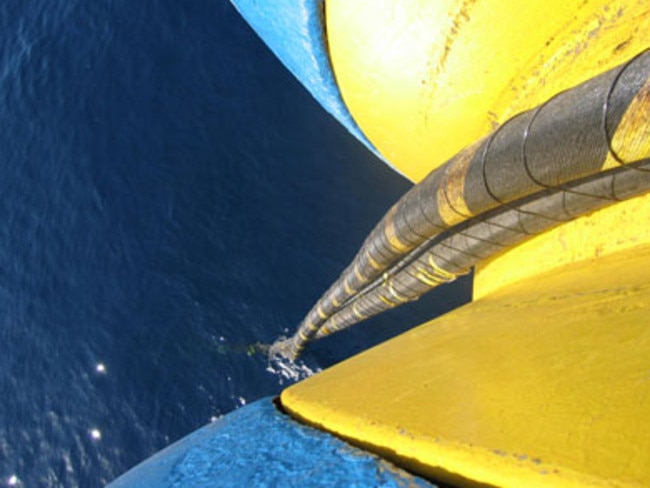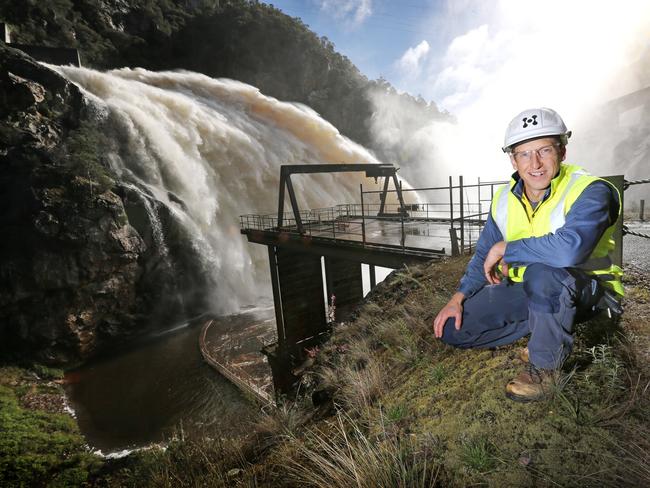Can Tasmania be the battery of the nation?
HYDRO Tasmania wants to develop up to 15 pumped hydro sites in Tasmania to realise the vision of this state becoming the “Battery of the Nation”.

Tasmania
Don't miss out on the headlines from Tasmania. Followed categories will be added to My News.
HYDRO Tasmania wants to develop up to 15 pumped hydro sites in Tasmania to realise the vision of this state becoming the “Battery of the Nation”.
But experts believe a second and potentially third cable across Bass Strait would be needed to fully capitalise on the energy generated.
Hydro this week told the Mercury it was carrying out early studies on a number of pumped hydro possibilities.
The Australian Renewable Energy Agency is also being asked to contribute $1 million to assess Tasmania’s role in the National Energy Market [NEM], including the opportunity for further wind development and potentially a second cable.
An announcement is expected in the near future.
Hydro said up to 15 sites could create an extra 2500 megawatts of capacity and effectively double Tasmania’s existing hydropower capacity.
The 5000 megawatts would be comparable to the Snowy 2.0 proposed increase from 4100 megawatts to 6100 megawatts.
Hydro Tasmania “Battery of the Nation” program director Chris Gwynne said the potential for Tasmania was enormous, dovetailed nicely into proposed wind and renewable energy developments and would dramatically improve the state’s energy security.
“Pumped hydro is the ability to go both ways uphill for storage and downhill for generation using the same water,” Mr Gwynne said.
“This means pump up into a top reservoir when prices are cheap.
“For instance when there is lots and lots of wind and solar and there is too much energy, [you can] use some of that to pump water and store the energy.
“Then when those forms of generation aren’t there, the water can then be run back down and generate.
“For every one unit of power you need to pump it up you get about 0.8 of a unit back when you generate.”

At present Hydro Tasmania exports over Basslink, which has capacity to export up to 630 megawatts for limited periods.
Capitalising on the pumped hydro storages would likely require two more cables over the next 10-20 years to cope with the increased load.
A recent report by the Australian Energy Market Operator tipped interconnectors to cost $940 million.
But Mr Gwynne said this would need to be explored.
“If Tasmania is going to install lots of pumped hydro and attract more wind investment, more interconnection is going to be something the market needs to address,” Mr Gwynne said.
“Interconnection is primarily an issue for policy makers and the whole market, because the whole market will benefit.
“But Hydro Tasmania is on record in saying there would be significant benefits from more interconnection, especially if we’re going to make all this new wind and solar work.”
A second interconnector also received a recent boost from Prime Minister Malcolm Turnbull.
“By building the mix of generation assets here in Tasmania, hydro, tidal or the new Cattle Hill wind farm announced in June or Granville Harbour wind farm to be built next year, you can see a future for much greater connectivity across the NEM,” Mr Turnbull said.
“That is why ARENA [Australian Renewable Energy Agency] is also going to continue to examine the prospects for a second interconnector across Bass Strait.”
Mr Gwynne said the “Battery of the Nation” idea was not just for Hydro’s benefit but would benefit the whole state by potentially unlocking a massive amount of investment across the regions.
“We believe there is a significant opportunity for Tasmania here in terms of future investment in our energy system which could go on for decades,” he said.
“It will enable us to fully use the potential which is on island and actually be able to sell those services to the mainland.
“We believe they’ll need these services in the future and that the Battery of the Nation idea is a cost competitive option.”
He said early studies had been promising.
“We have done some high- level analysis looking at what we think the development on island would be and comparing that with other options in the NEM for the sort of potential and it looks very attractive,” he said.
“We make a lot of assumptions because it is a high-level analysis but it does tell us that it is worth us putting a fair amount of effort into developing it out properly.
“Our first-cut analysis looks really attractive and we will be looking to publish some of that shortly.”

The Battery of the Nation vision also is slated to include joint Hydro and ARENA studies into the feasibility of redeveloping the Tarraleah Power Station at a possible cost of $650 million and a project in the order of $30 million to augment the existing Gordon Power Station through the addition of a smaller turbine to better manage environmental flows through the station.
ARENA is examining whether to contribute up to $500,000 to a feasibility study with Hydro Tasmania contributing a similar amount.
Hydro hopes to make a further investment decision by the end of this year.
While Mr Gwynne wouldn’t comment directly on the prospect of a Clean Energy Target, he said Hydro Tasmania and Battery of the Nation would be helped by the general market reforms advocated by chief scientist Alan Finkel in his report.


